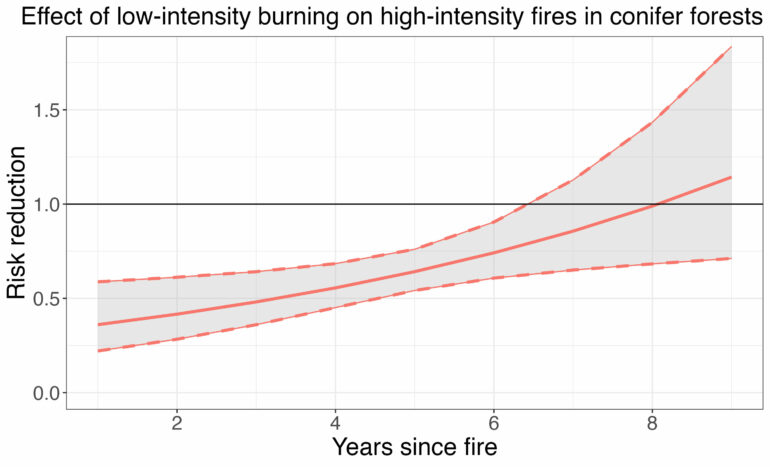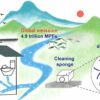There is no longer any question of how to prevent high-intensity, often catastrophic, wildfires that have become increasingly frequent across the Western U.S., according to a new study by researchers at Stanford and Columbia universities.
The analysis, published Nov. 10 in Science Advances, reveals that low-intensity burning, such as controlled or prescribed fires, managed wildfires, and tribal cultural burning, can dramatically reduce the risk of devastating fires for years at a time. The findings—some of the first to rigorously quantify the value of low-intensity fire—come while Congress is reassessing the U.S. Forest Service’s wildfire strategy as part of reauthorizing the Farm Bill.
“I’m hopeful that policymakers will rely on this work as motivation and support for the scale-up of beneficial fire as a key strategy in preventing wildfire catastrophes,” said study co-author Michael Wara, director of the Climate and Energy Policy Program at the Stanford Woods Institute for the Environment. “Beneficial fire is not without its own risks—but what our study shows is just how large and long-lasting the benefits are of this crucial risk reduction strategy.”
Significant risk reduction
The study, which focused on California, comes almost exactly five years after the state suffered its deadliest wildfire on record, the Camp Fire. Hotter weather and a history of fire suppression have allowed the build up of tinder-dry trees and brush, which fuel increasingly destructive wildfires. It wasn’t always that way.
For millennia, Indigenous people allowed wildfires to burn, and intentionally applied fire to the land for reasons ranging from ceremony to subsistence. As a result, pre-colonial forests across California contained less fuel for hungry flames and were better able to retain moisture—keys to fire and drought resilience.
It’s no secret that wildfire-prone regions need to shift from a single-minded focus on suppression to one that includes much more controlled burning and forest resilience. Previous Stanford-led research has shown that California alone needs fuel treatments—whether prescribed burns or vegetation thinning—on about 80,000 square kilometers or nearly 20% of the state’s land area.
However, until now, studies assessing the beneficial effects of prescribed and low-intensity fires have been limited to relatively small areas, such as a single wilderness area or watershed. For this paper, the researchers reviewed 20 years of satellite monitoring of wildfires across more than 100,000 square kilometers of California forests.
The team—fire policy experts, public health scientists, and statistical and machine learning researchers—harmonized multiple state-wide datasets on fuel characteristics and fire behavior, including fire intensity (measured by the amount of energy released) and fire severity (measured by the ecosystem impacts of large fires).
Previous studies have shown that prescribed fires and unplanned low-intensity wildfires have similar risk-reduction effects. Both remove surface fuels and smaller diameter trees, thereby helping forests achieve a more fire-resilient mix of trees and preventing fires from growing too intense. Both also leave tree canopies intact due to relatively low flame heights.
The authors measured the protective effect of low-intensity fires using a method that assembled unburned areas into a synthetic landscape closely resembling the burned landscapes’ attributes, such as weather patterns, elevation, vegetation type, and disturbance history. This approach allowed them to assess how these burned landscapes might have evolved had they not burned in that same year—and compare these counterfactuals to their actual evolution throughout time.
Using this approach, the researchers were able to quantify the reduced risk of high-intensity fires after a low-intensity fire burns in a forestland, and then see how long the protective effect lasts.
They found that low-intensity fire in mixed conifer forests in California initially provides a 60% reduction in risk of catastrophic fire, and this effect lasts at least six years but diminishes over time. They also found a smaller but still significant reduction in risk in oak-dominated forests.
Good timing
Policymakers could use the study’s results as a foundation for future evaluation of wildland fuel treatments by comparing the quantified benefits to potential costs and risks associated with its implementation.
The timing is good: The U.S. Forest Service has proposed treating nearly 200,000 square kilometers (about 50 million acres) over the next decade through a mixture of fuel treatment strategies. California has proposed increasing the amount of land it treats for wildfires to 2,000 square kilometers (about 500,000 acres) annually.
To be effective, wildland fuel treatments, including prescribed burning, have to be ongoing, periodic maintenance rather than a one-time intervention for forests that are adjacent to communities or critical infrastructure, the researchers write. The risk mitigation benefit of low-intensity burning will depend heavily on careful selection and targeting of the intervention to provide maximum protection for people, communities, and ecosystems.
“This study exemplifies how data science can contribute to climate mitigation through a highly multidisciplinary collaboration,” said study lead author Xiao Wu, an assistant professor of biostatistics at Columbia University who worked on the paper as a Data Science Fellow at Stanford.
“Wildfires present substantial threats to both our ecosystems and human well-being. As scientists, our constant goal is to find practical solutions.”
More information:
Xiao Wu et al, Low-intensity fires mitigate the risk of high-intensity wildfires in California’s forests., Science Advances (2023). DOI: 10.1126/sciadv.adi4123. www.science.org/doi/10.1126/sciadv.adi4123
Provided by
Stanford University
Citation:
Low-intensity fires reduce wildfire risk by 60%, according to study (2023, November 10)



